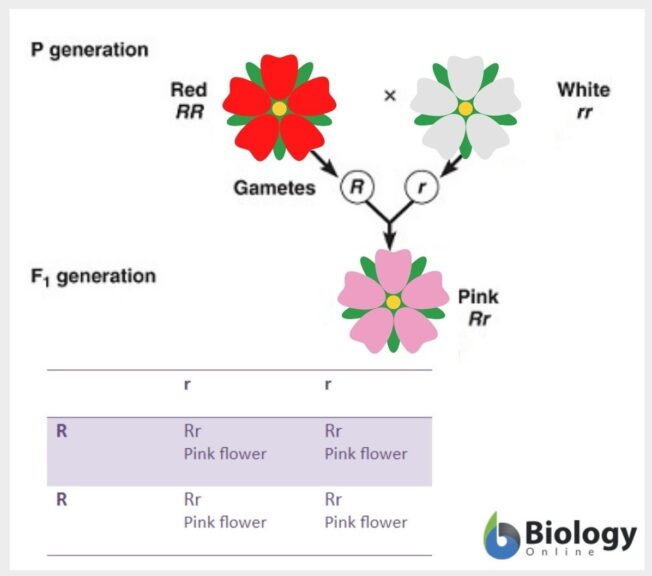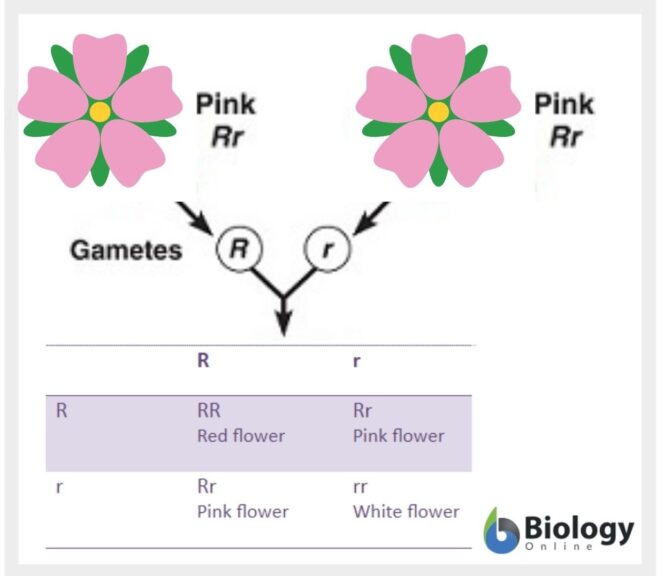
Incomplete dominance, a phenomenon that is responsible for variations in different life forms leading to enhanced and better reforms through the genetics used by humans.
Table of Contents
After Gregor Mendel discovered inheritance laws, the term ”incomplete dominance” was proposed by the German botanist, Carl Correns (1864–1933). Carl Correns continued research and conducted an experiment on four o’clock flowers. This experiment leads to the discovery of incomplete dominance–a condition in which a heterozygous individual doesn’t show a dominant allele but rather shows an intermediate phenotype of the phenotypes of the dominant and recessive alleles.
Although we commonly refer to different alleles as being dominant or recessive, dominance is a property of the phenotype. There are many forms of dominance: complete dominance, incomplete dominance, and codominance. In complete dominance, there is no difference in phenotype between AA and Aa individuals. In incomplete dominance, the phenotype in a heterozygous individual is visibly less intense than that in an individual homozygous for the dominant allele, so that AA and Aa genotypes produce different phenotypes. Hence, the heterozygote (Aa) will have a phenotype intermediate between that of AA and aa individuals.
Incomplete dominance is defined differently as follows:
According to some definitions, there are several assumptions about incomplete dominance; incomplete dominance occurs due to the combination of parent alleles, both dominant and recessive. Whereas, several definitions define incomplete dominance as a phenomenon in which the heterozygote possesses an intermediate trait between the two homozygous traits. Moreover, some definitions show incomplete dominance where the new offspring has a specific trait with less intensity than the dominant trait among the paired alleles. In other words, the trait is not completely dominant — or, it is neither dominant nor recessive.
The situation in which the phenotype of the heterozygous organism is clearly manifested is a cross between two homozygous phenotypes. After the combination of homozygous alleles (F1 generation), the heterozygote will have the intermediate trait. At F2 generation, it, then, shows a phenotype ratio of 1:2:1 phenotype in which the two are intermediate traits and the others are either dominant or recessive traits.
In incomplete dominance, both alleles of the homozygous genotypes are not expressed over one another; rather, an intermediate heterozygote is formed. Incomplete dominance is a key role factor in the variation of an organism’s features or characteristics.
To understand the mechanism of incomplete dominance, the botanists use the Punnett square. The Punnett square predicts the genotype of the breeding experiment. In this case, one plant producing red flowers and another plant producing white flowers are crossed.

The above Punnett square results in heterozygous offspring with an intermediate trait of pink color, showing that no allele gets dominated over the other. The two alleles are not expressed in a way to hide the effect of the other allele; instead, the phenotype is in between the two, thus, resulting in an intermediate. Thus, the heterozygote is one that produces flowers with a pink color. This example illustrates how the presence of three alleles and their interaction through incomplete dominance can lead to a range of phenotypic outcomes, allowing for various coat colors that don’t strictly adhere to the characteristics of any single allele.
For F2 generation, the heterozygotes are crossed to see the respective phenotypes.

The phenotype in the F2 generation results in the same ratio as proposed by Mendel, i.e., 1:2:1. The offspring phenotypes were 25% red flowers, 25% white flowers, and 50% pink flowers. This shows that incomplete dominance does not necessarily involve absolute blending because the heterozygote contains both distinct traits or alleles, i.e., red and white color, which after crossing the heterozygotes in the F2 generation, the red and white color traits still appear. Moreover, in incomplete dominance, the offspring contain both alleles, but the alleles’ expression gets a blended phenotype of the two parental traits.
A typical example is the color of the flower in which R symbolizes the dominant allele for red pigment and r is the recessive allele for no pigment. In incomplete dominance, the plant with heterozygous genotype (i.e., carrying heterozygous alleles, Rr), will not be able to produce enough pigment for red flowers, since the amount of pigment produced under the direction of the single R allele is insufficient for full color and therefore will appear pink.
Incomplete dominance is a widely studied phenomenon in genetics that leads to morphological and physiological variations. The pink flower color trait, which is an example of incomplete dominance, occurs in nature, such as those found in pink-flower-bearing angiosperms. Turns out the dominant allele is not expressed “completely” as shown in Figures 1 and 2 – incomplete dominance (Punnett square). Apart from plants, incomplete dominance also occurs in animals and humans. For example, hair color, eye color, and skin color traits are determined by multiple alleles in humans. Take a look at the examples below for the incomplete dominance in plants, humans, and other animals.
Snapdragon also shows incomplete dominance by producing pink-colored snapdragon flowers. The cross-pollination between red and white snapdragons leads to pink color flowers because none of the alleles (white and red) is dominant.
Incomplete dominance is used to improve corn crops as the partially dominating traits of corn are generally high yielding and healthier than the original ones with fewer traits.
The multiple alleles occupy the same locus of the chromosome within an organism which causes varying organisms’ varying characteristics. In plants, the self-sterility n is an example of multiple alleles that causes the rapid growth of pollen tubes.
Despite the concept of adaptation of incomplete dominance by humans in genetics to increase better living, incomplete dominance can also be seen in humans genetically. The crossing of two different alleles in the genetic process produces human offspring either with different or intermediate forms between the two traits. Thus, it can be said that incomplete dominance is as old as human life that leads to variation with time.
Most of the physical characteristics of humans, including hair, eye color, height, skin color, sound pitch, and hand size, show incomplete dominance. Children born with semi-curly or wavy hair are an example of individuals exhibiting incomplete dominance because of the crossing of parents’ alleles both straight and curly hairs to produce such offspring. Thus, incomplete dominance occurs to produce an intermediate trait between the two parent traits. The eye color of humans is a more common example of incomplete dominance. However, understanding incomplete dominance for eye color is quite complicated.
Human height patterns also show incomplete dominance. Parents with different heights have offspring that show height in between the parent’s height range rather than similar to any one of the parents.
Human skin color is another example of incomplete dominance because the genes that produce the melanin (pigment) for either dark or light skin cannot show dominance over the other. Thus, the offspring produced have an intermediate skin color between the parents.
Usually, male humans have high-pitched sounds, and other homozygotes have reduced sound pitches. The resulting heterozygote individual would have an intermediate voice pitch rather than high or low sound pitches.
Similar to the above characteristics of humans, hand sizes also show incomplete dominance in the same manner. The offspring will have intermediate or medium-sized hands as compared to his/her parents.
Also, carriers of Tay-Sachs disease show incomplete dominance. In Tay-Sachs, the individuals do not have enzymes responsible for breaking down the lipids, leading to the accumulation of lipids all over the body, especially in the brain and nervous system. The lipid accumulation leads to the loss of abilities, both physical and mental, due to nerve deterioration. Another disease named familial hypercholesterolemia (FH) shows incomplete dominance. One type of allele causes the generation of liver cells either normally or without the receptors of cholesterol. Thus, incomplete dominance causes these cells unable to fully remove the excess cholesterol from the blood.
When long and short-furred rabbits are bred together, the offspring produced have varying lengths of fur (medium). Usually, the breeding of a short-furred Rex and a long-furred Angora produces medium-length furs.
Similarly, the dog’s tail’s length also shows incomplete dominance. When a long-tailed dog parent is bred with a short-tailed dog parent, the offspring produced has a medium-sized tail. Another example is the labradoodle. They have wavy hairs that result when the straight and curly-haired parent dogs are bred.
The other example includes the spots on animals’ bodies more visible in cats, dogs, and horses. When bred (a more spotted animal with a less spotted animal), these animals will produce offspring with varying spots (less than more spotted parent and more than less spotted parent).
![]()
Be in touch with an expert! Join our Forum discussion: Incomplete dominance vs. codominance. Let’s catch up!
Now you are able to identify the incomplete dominance examples in different life forms due to a better understanding of the respective term. Plus, next time you will go out somewhere, you will see which flowers show incomplete dominance and other small pets.
Moreover, try to explore yourself first, look at the characteristics you differ from your parents, and find if any one of those features shows incomplete dominance, such as your hair, sound, hand size, or height.
You can also practice crossing different alleles and seeing what characteristics the offspring will have by using the Punnett square.
Lastly, think about what you can add for better life forms by using the concept of incomplete dominance.
Try to answer the quiz below to check what you have learned so far about incomplete dominance.